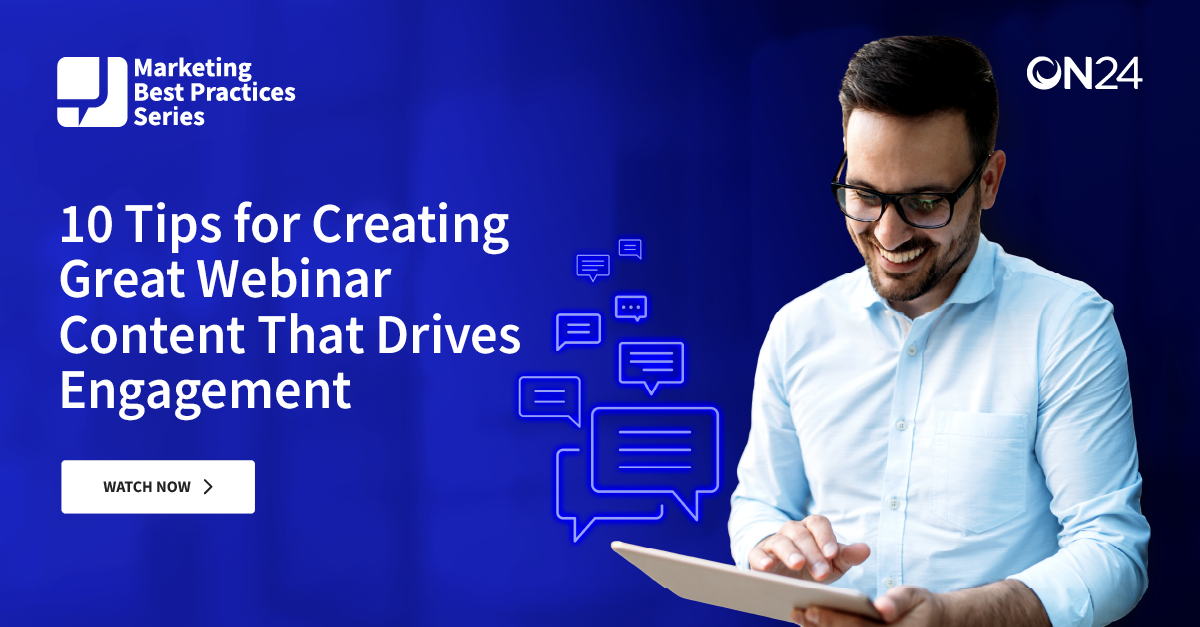A lot of people hear the word “webinar” and think of a boring lecture that’s accompanied by a PowerPoint and no audience engagement – but in reality, that’s the webinar of a bygone age.
Nowadays, webinars are so much more than a talking head. They incorporate different styles, techniques, technology and tools that can come together to create an engaging, interesting topic with thousands of participants.
One incredibly underrated webinar format is the panel webinar. At its most fundamental level, a panel webinar consists of two speakers and a moderator. It’s a familiar format often used at conferences and trade shows, but it’s also highly effective to engage a virtual audience.
Panel webinars can come in several different styles, like coffee conversations, deep topic dives, all-hands meetings, fireside chats and so on. The tone of your industry and the topic of conversation usually determine the discussion format.
How Can You Plan a Panel Webinar?

You need to take several steps to plan a successful panel webinar. However, first, you need to have a date for your event. We recommend planning your webinar six to eight weeks in advance before you want the event to happen.
Once you have a date down, decide on a topic and consider what panel format will be the most effective for the subject. Events or activities connected to this panel webinar — like a virtual summit — may also influence the style of the webinar you host. Ask yourself: Is this a stand-alone event? Part of a summit or conference? Connected to an ongoing campaign or series of other webinars?
Now that you have a topic and style of webinar, you need to think about who will speak and moderate. If you have a go-to moderator, see if he or she is comfortable with a panel webinar. It will be different from other webinars they’ve moderated before because they need to balance two additional speakers while keeping the conversation moving forward and flowing naturally.
Suppose you don’t have a moderator in mind. In that case, you need to look for someone with a solid personality to lead the discussion while being knowledgeable enough to contribute. A good moderator for panel webinars can multitask in front of an audience, balance and guide the speakers, manage audience input and keep track of timing.
As for guest speakers, there are a few options. You can always stick to employees, but we like to branch out and hear from other businesses to see their advice and insight about the topic. You could also use this to connect with businesses or leaders who are more difficult to secure a meeting with, which would be a great way to expand your enterprise.
To select speakers, start by examining the partners you have a close relationship with and work outward from there. Sponsors and industry thought leaders are also excellent options to consider — and both can net a larger number of attendees. No matter who you pick, the most important thing is to make sure they know enough about the topic to hold an unscripted conversation that is relevant and meaningful to the audience.
Panel Webinar Logistics

At this point, you’re ready to sit down with the team and get into the details of the event. Think of this as the kickoff meeting where the high-level decisions are made and delegated to the appropriate team member.
Your task list for this meeting needs to include several things:
1. Determine which platform is going to host your event.
Different companies have different webinar platforms they prefer. Ask your partners and panelists about which platforms they have available to use and select the platform that has the most robust features. At a bare minimum, the platform you use should have opportunities for audience engagement through chat, Q&A, downloadable resources and interactive polls.
2. Will you meet digitally or in person?
Right now, it will probably be entirely digital, but note that before the pandemic, many panel webinars had the speakers and moderator in the room together. This helps give the webinar a more conversational style since the speakers interact.
3. Introduce the speakers and moderator to each other and exchange contact info.
Or if they already know one another, have them confirm current contact info. The speakers and moderators need to be familiar and comfortable enough around each other to have a 45-minute conversation in front of an audience.
Have them share their high-level background and experience on the topic and any specialties they may have related to the topic. This helps determine who speaks on certain topics and who can answer questions in the Q&A.
4. Highlight any key topics that need to be covered or avoided in the discussion.
With trends constantly in flux, there may be certain items you want to ensure are covered or avoided in the conversation. Make everyone aware of this as early on as possible.
If there is enough time, create a rough outline of the road you’d like the conversation to take. The speakers and moderator can divvy up topics to discuss and make plans to chat again with a more detailed outline. If there isn’t enough time for this, plan a sidebar meeting with the necessary team members to review the topics later.
5. Determine air time, replays and on-demand.
Since all events are digital for the time being, you need to decide if you will host your webinar live, simulive or both. It’s important that you don’t forget to think about your audience when making this decision.
When deciding, here are some questions to ask and discuss: Is your business or your speakers’ businesses international? Do you need to consider attendees in multiple time zones? Do the speakers feel comfortable having the conversation live or would they rather pre-record it in case of errors? If you’re going to run this simulive, who will be online to answer questions for each of the air times? Are the speakers available to answer multiple rounds of questions?
6. Go over any initial concerns or roadblocks you foresee.
Ask your team members if they have any concerns or anticipate any potential problems. It’s better to know about them as early as possible so you can plan solutions. See if your speakers have any technology needs like a microphone, camera, etc., to make the webinar successful.
7. Discuss the Q&A portion at the end of the webinar.
Is the team comfortable with live, unfiltered questions or would they rather have advanced notice to prepare correct answers?
Sometimes, webinars have scripted questions and answers ahead of time. This can be useful if you need to answer questions on certain topics delicately if a speaker is nervous and worried about messing up, or just to get the ball rolling. No one likes to be the first person, so a canned question or two at the beginning makes the audience more comfortable asking more.
If your team chooses to go with a live Q&A, you can still anticipate certain questions and prepare answers beforehand. Your speakers and moderator are probably leaders in the topic’s field and have a good idea of some potential questions they may be asked. There is no right or wrong way to do a Q&A so use the most comfortable method for your speakers.
Panel Webinar Marketing

You have your topic, webinar style, speakers and event dates and times decided. Now you need to plan how you will market your panel webinar. The host organization typically leads this with input from the speaker’s businesses.
Create a packet of information that you can share with the partner companies so they can help promote the webinar. In addition to the webinar logistics like the dates and times, this packet should include all the assets that go into the marketing of a webinar, such as social media plans, email blast content and dates, plans for images and graphics, speaker bios, registration page content, sample social media messages, and any hashtags, handles or tags that should be included in social media posts.
Before this package is disseminated to the different groups helping create and post the content, give your partner companies time to review and recommend changes that may impact their business. You want these companies to post and advertise this webinar on their channels, too, so unanimous buy-in is essential.
Much of the content that goes into an asset package is going to be created or implemented by different people in different departments. Make sure everyone knows the due dates for their work by including them in the asset package if possible.
Drive engagement During the Webinar
Webinars are a fantastic tool for lead generation because they gauge participant’s interest and engagement. Give participants opportunities to engage with the panelists through polls, social media, survey and Q&A widgets.
If you’re running a simulive webinar, have sales representatives or panelists available to answer questions throughout the webinar. If you’re offering the webinar on-demand, have questions routed to someone and make sure the necessary people follow up with an answer and get back to the viewer.
Share Results After the Webinar

In many cases, the host organization agrees to share the webinar results — a certain number of registrant emails, for example — with the partner businesses. This tactic can be used as part of a recruiting tool to secure desirable speakers. By offering the analytics and results, all participating organizations have access to the same information and can use it to follow up on leads.
Although much planning and effort goes into creating a panel webinar, they do get easier the more you do them. Your attendees will also appreciate a different style of webinar to keep things fresh.
Overall, be sure to have fun, communicate often with the business partners involved, and keep a list of past panelists for any future events.


